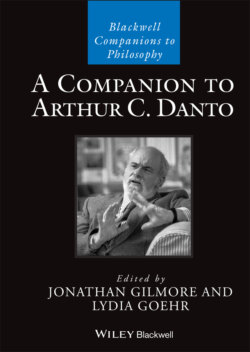Читать книгу A Companion to Arthur C. Danto - Группа авторов - Страница 23
4 Art History Ended in My Garden
ОглавлениеAs should be clear by now, it is impossible for me to write about Arthur Danto without touching upon our personal friendship, which outgrew our intersecting professional interests. We shared a lot, beyond our love of art and our interesting birthdays – January 1, set apart by four decades – and names that rhymed.
On a sunny May afternoon in a Los Angeles garden, years after I first knocked on his office door, Arthur delivered a speech at my wedding – a speech that was subsequently published in an essay titled “Philosophers and the Ritual of Marriage” (Danto 2008, 7–14). In what must have come as a surprise to some of the assembled, he canvassed the history of philosophy to search for an answer to a question that my future wife – who by happenstance had studied philosophy – and I had posed to him in preparation for the ceremony, namely: Why would two free individuals, unencumbered by custom, economics, or religion, enter a binding relationship of a kind that marriage represents? Socrates, Leibniz, Kant, and of course, Hegel were among those cited. The essay is rarely quoted, so I share the gist here:
Even as an Aristophanic whole, engaged in a Odyssian form of the connubially connected life, wedding is a social act, fraught with meanings. We want most immediately to give those we love – family and friends – a symbolic participation in our evolving condition – and the ceremony of wedlock transforms the company into symbolic union with ourselves. It is an acknowledgement that we do not because we cannot in the end live for ourselves alone. It admits some wider relevant society into our happiness, and creates through ceremonial enactment an entity larger than ourselves (Danto 2008, 13).
True to form, Arthur made the essay another opportunity to opine about boundary lines that fence off the ordinary from that which is more meaningful. In any event (as Arthur would say in moments of transition like this), the wedding was not the end of our story. A closeness developed between our families. Arthur and his wife, Barbara, took a keen interest in our children, which is how we learned that the Johnsonian Professor Emeritus of Philosophy at Columbia University had considered opinions on each of the Harry Potter novels, which he had eagerly read.
What continues to link us even after his passing, in the most tangible way, is Arthur’s former weekend house, in Brookhaven Hamlet, Long Island. He was deeply attached to this hideaway, which he had bought for a song in the early 1970s. It is where he wrote, voted, and thought. He even worked to help the area get a historically protected designation. He developed friendships with people in the neighborhood, including scientists from the nearby Brookhaven National Laboratory. He took walks to the Carmans River Estuary, at the end of the street, and on sunny days would drive out to the ocean beaches at Smith Point Park. For some reason, my wife and I were entrusted with the care of the modest cottage for periods of summertime house-sitting. When Arthur’s physical condition frayed as he reached his eighties, it was no longer feasible for him to use the house, and he offered it to us to buy. The house and its garden have since become the anchor of my own family. Much of what is good about our lives happens there. It is where we feel we are “an entity larger than ourselves.”
Arthur had converted a garage on the property into a writing studio. He installed a skylight and hung a Chinese print. This is where he wrote some of his most seminal works, including The Transfiguration of the Commonplace, and various texts in which he put forward his theory of “the end of art.” The humble shed was a launching pad for ideas that left a lasting mark on our world. I take occasional delight in telling my friends that art history, so to speak, ended in our garden.
